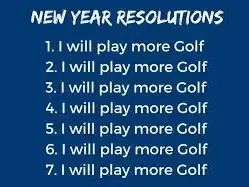Tee Off to a Better Game: New Year's Golf Resolutions
The New Year is a time for fresh starts and renewed motivation.

What better way to embrace that spirit than by setting some golf resolutions to elevate your game? Whether you're a seasoned player or a weekend warrior, dedicating yourself to improvement can bring immense satisfaction and lower scores. So, as you bid farewell to the old year, let's tee off to a better game with these achievable and impactful New Year's golf resolutions:
1. Practice with Purpose, Not Just Practice:
Hitting a bucket of balls without a plan is a common trap. This year, resolve to make your practice sessions more purposeful. Focus on specific aspects of your game that need improvement.
- Short Game is King: Dedicate more time to chipping, pitching, and putting. Lower scores often hinge on a solid short game.
- Drill Down: Incorporate drills to address weaknesses. Work on consistent ball striking, distance control, or putting accuracy.
- Track Your Progress: Keep a practice journal to monitor your progress and identify areas that need further attention.
2. Embrace Fitness for Golf:
Golf is a physically demanding sport, even if it doesn't always feel like it. Improving your fitness can significantly enhance your performance on the course.
- Core Strength and Flexibility: Focus on exercises that build core strength, improve flexibility, and increase rotational power. Yoga, Pilates, and strength training are excellent options.
- Cardiovascular Endurance: Walking 18 holes is great exercise, but adding some cardio workouts to your routine will improve your stamina and help you stay fresh throughout the round.
- Warm-up Properly: Before each round or practice session, dedicate time to a dynamic warm-up that prepares your muscles for the demands of the swing.
3. Invest in Lessons from a Pro:
Even the best golfers in the world have coaches. A qualified PGA professional can identify flaws in your swing, provide personalized instruction, and help you develop a more efficient and consistent game.
- Identify Your Weaknesses: A pro can quickly pinpoint areas where you're losing strokes and develop a plan to address them.
- Break Bad Habits: Long-standing swing flaws can be difficult to correct on your own. A pro can help you break bad habits and build a more solid foundation.
- Learn Course Management: Beyond the swing, a pro can teach you valuable course management skills, helping you make smarter decisions on the course.
4. Sharpen Your Mental Game:
Golf is as much a mental game as it is a physical one. This year, resolve to strengthen your mental fortitude.
- Develop a Pre-Shot Routine: A consistent pre-shot routine can help you focus, manage pressure, and execute shots more effectively.
- Practice Visualization: Before each shot, visualize the desired ball flight and outcome. This can enhance your confidence and improve your execution.
- Stay Positive: Golf can be frustrating. Learn to manage your emotions, stay positive, and focus on the next shot, not the last one.
5. Play More, Play Smart:
There's no substitute for playing rounds of golf. The more you play, the better you'll become at reading greens, judging distances, and managing different course conditions.
- Play Different Courses: Challenge yourself by playing a variety of courses with different layouts and challenges.
- Keep Track of Your Stats: Analyze your rounds to identify areas where you can improve. Track fairways hit, greens in regulation, and putts per round.
- Play with Better Golfers: Playing with more skilled golfers can be a great learning experience. Observe their techniques, strategies, and course management.
6. Upgrade Your Equipment (Strategically):
While new clubs won't magically transform your game, having equipment that fits your swing and playing style can make a difference.
- Get Fitted: A professional club fitting can ensure that your clubs are properly matched to your swing speed, launch angle, and other factors.
- Consider a New Putter: The putter is the most used club in the bag. If you're struggling on the greens, a new putter or a putter fitting might be a worthwhile investment.
- Don't Chase the Latest Tech Blindly: Focus on finding equipment that genuinely improves your game, not just the latest and greatest marketing hype.
7. Embrace the Journey:
Lowering your handicap takes time and effort. Don't get discouraged if you don't see immediate results. Celebrate small victories, enjoy the process, and remember that the journey of improvement is just as rewarding as the destination.
Conclusion:
By setting realistic and achievable New Year's golf resolutions, you can set yourself up for a year of improvement and enjoyment on the course. Focus on purposeful practice, physical fitness, professional guidance, mental toughness, and smart play. Embrace the challenge, be patient with yourself, and you'll be surprised at how much your game can evolve in the New Year. Here's to lower scores and more enjoyable rounds in the year ahead!
This is Golf as You've Always Imagined!
Daniel is a Top 100 golf Coach, PXG Staff Pro, World Long Drive Coach and the Head of Golf Instruction at IMAGEN Golf the area's leading golf instruction and advisory firm, host of the IMAGEN Golf podcast and Best-Selling Author of "Unleash The Golfer Within".
For more information visit www.ImagenGolf.com or call 215-595-6299 Reach out to Daniel directly at:Daniel@ImagenGolf.com
For free golf tips and more listen to The IMAGEN Golf Podcast on Spotify, Apple Podcast or wherever you get your podcasts and follow us:
Instagram @ Imagengolf
Twitter @ imagengolf
Facebook Imagengolf
TikTok @ GolfBetterGuaranteed
Youtube ImagenGolf










